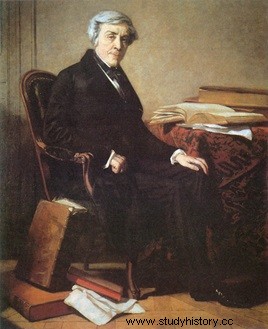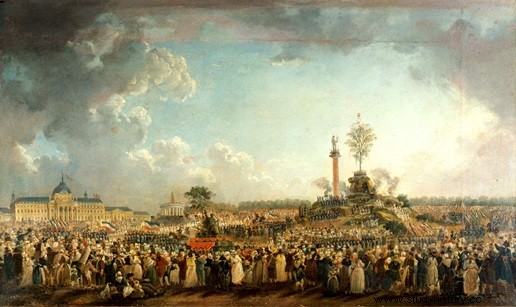 Jules Michelet was born on August 21, 1798. His childhood was spent in an environment of poverty and popular indignation . His father was a printer during the Revolution but after the arrival of Napoleon and the Restoration the number of printers was reduced, as the freedom of the press was limited, and misery took over most of them. The first hard years of young Michelet's life forged his character.
Jules Michelet was born on August 21, 1798. His childhood was spent in an environment of poverty and popular indignation . His father was a printer during the Revolution but after the arrival of Napoleon and the Restoration the number of printers was reduced, as the freedom of the press was limited, and misery took over most of them. The first hard years of young Michelet's life forged his character.
According to what he himself tells us, the visit to the Museum of French Monuments and the reading of the medieval Imitation of Christ influenced his decision to opt for the study of history. At 12 years old, small and emaciated by malnutrition, he entered the Charlemagne Lyceum. Once he finished teaching him, he was added to history in 1821 at the Charlemagne Lyceum itself and, later, taught this discipline at the Santa Bárbara College. Six years later he was appointed professor of philosophy and history at l’ École preparatoire from Paris.
As his reputation grew, he held more public positions:in 1830 head of the historical section of the National Archives, in 1834 Guizot's deputy at the Sorbonne, in 1837 professor at the Collège de France in the chairs of history and morals and in 1838 member of the Academy of Moral and Political Sciences. Shortly before the Revolution of 1848 began, he was dismissed from his teaching positions but will be reinstated after the Second Republic was proclaimed. The arrival of Louis Napoleon Bonaparte to power caused, once again, that he was relieved of his functions when he was accused of maintaining a position hostile to the Second Empire. He died on February 9, 1874 in Hyères.
Michelet's literary production is very extensive. His first works, published in 1831, are the History of the Roman Republic and the Introduction to Universal History . The latter, influenced by the writings of Giambattista Vico, swings between the philosophy of history and the history of civilization in the style of Guizot, but in any case placing France as the center of Europe.
Shortly after, he began one of his most important works, the History of France , composed of twenty-four volumes written between the years 1830 and 1867, whose preparation was somewhat chaotic. He wrote without following a fixed plan, choosing those moments or times that most attracted him. The first six volumes cover from the beginning of Gallic history to the reign of Louis XI and were written between 1830 and 1847. It was not until 1855 that he took it up again because during this period he dedicated his time to writing the work that would give him more fame, the History of the French Revolution . In the last years of his life he began writing a final volume of the History of France dedicated to the 19th century but he passed away before completing it. The Tableaux de France stand out. included in the second volume, in which he describes the French provinces and explains the variations in character of their inhabitants, highly conditioned by physical and geographical elements. Michelet's last works are a hybrid between naturalism and scientism:The sea , The insect or The Mountain they are very lyrical books in which he approaches a kind of pantheism.
 On the History of the French Revolution Michelet condenses his vision of history. For him, the revolution was carried out by the French people, who became the anonymous hero, the great mass that, apparently discordant, walks united by a common feeling and an instinctive inspiration. The actors and speakers who intervened and achieved fame in these years interpret the thought of the masses in their speeches. The town is the protagonist and his work is dedicated to it. The only way to reflect his action is to study the deep transformations of the popular spirit and for this he observes the life of the mob and the changes it undergoes under the pressure of events, explaining what could be understood as the psychology of the revolution.
On the History of the French Revolution Michelet condenses his vision of history. For him, the revolution was carried out by the French people, who became the anonymous hero, the great mass that, apparently discordant, walks united by a common feeling and an instinctive inspiration. The actors and speakers who intervened and achieved fame in these years interpret the thought of the masses in their speeches. The town is the protagonist and his work is dedicated to it. The only way to reflect his action is to study the deep transformations of the popular spirit and for this he observes the life of the mob and the changes it undergoes under the pressure of events, explaining what could be understood as the psychology of the revolution.
This view of history is opposed to that defended by Tocqueville or Von Ranke, who gave preponderance to the facts. Michelet relegates these to the background and rather describes the shouting, the movements, the effervescence of spirits and imaginations during those very turbulent years. Before dealing with a character he dives into his environment and the influences he receives from his environment. He writes, in reality, a history of the interiority of historical phenomena, whose causes no longer have value, since what is important lies in the identities that emerge from the feelings of the people.
Although it may seem that Michelet's work is impregnated with a strong subjectivism (as is sometimes the case), the documentary base he uses is immense. He will be the first to use the documents stored in the central archives, or in those of the prefectures and municipalities. There is no denying his attempt to be objective. In History of France he manages to preserve, in a way, the neutrality of his story, but in the History of the French Revolution he loses his cold blood and floods the work with appraisals, criticisms and opinions. His style, consistent with the purpose of the work, sometimes resembles the novel. He combines the work of a historian with the art of writing and captivating. For this he resorts to a wide range of stylistic resources:analogies, vitalist metaphors and anthropomorphic figures.
